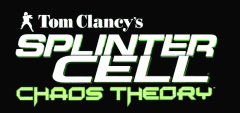Gainward 8800GTS GS
8. Splinter Cell Chaos Theory
 A Japanese Information Defense Force is formed to help face modern threats. Deemed a violation of international law and of the Japanese Post-War Constitution, Korea and China become outraged.
A Japanese Information Defense Force is formed to help face modern threats. Deemed a violation of international law and of the Japanese Post-War Constitution, Korea and China become outraged.
Secretly, the head of the IDF begins launching information-warfare attacks against Japan and blaming the attacks on North Korea. When the U.S. intervenes, as they are obligated to under Article 9 of the Japanese Post-War Constitution, the U.S. is attacked as well, forcing North Korea to escalate the situation with a pre-emptive invasion of South Korea. As war erupts on the Korean Peninsula, Sam Fisher must thwart the alliance between the Japanese Admiral, a neurotic computer hacker, and the head of an international paramilitary company in order to prevent the rekindling of a massive world war in the Pacific.

The graphics engine supports Pixel Shader 1 and 3, HDR along with other new effects. We used hocbench which offers all benchmarking options from an easy to use GUI. We used the built-in "Guru3D 2" timedemo and all results are posted below, using SM1.1

The Gainward 8800GTS GS posts an impressive 121FPS, 8 frames per second more than the 7950GT SLI. Splinter Cell - Chaos Theory also supports Shader Model 3.0 that can be enabled easily from within hocbench:


SM3.0 offers much better visual details but at the cost of lower performance. Here, we saw that the 7950GT SLI was more powerful. Splinter Cell Chaos Theory doesn't offer AA/AF modes, but they can however be enabled from Nvidia's Forceware 3D Control panel.

Enabling AA/AF drops performance for all cards, except the Gainward 8800GTS GS. Remember that 8800 series can do HDR and AA at the same time, like the 1950XTX series. That's why the performance penalty for the 8800GTS GS was zero.





















